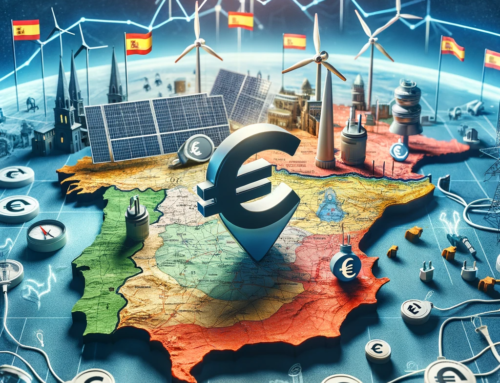How FLEX Markets and EMS Can Revolutionize Spain’s Energy Landscape
As the global energy landscape continues to evolve, the need for flexible, consumer-centric energy solutions has become more pressing than ever. The concept of the FLEX market has emerged as a critical innovation in balancing energy supply and demand, particularly in regions with high renewable energy penetration. In Spain, where solar energy potential is vast, the FLEX market offers a unique opportunity to optimize energy usage, reduce costs, and empower consumers. However, while the FLEX market has seen significant adoption in Northern Europe and Scandinavia, Spain’s journey is just beginning. This article explores the potential of the FLEX market in Spain, the role of advanced Energy Management Systems (EMS) like Markedroid in facilitating this transition, and why major utilities like Iberdrola should consider embracing these technologies.
Despite Spain’s solar energy potential, the adoption of the FLEX market lags behind Northern Europe and Scandinavia, where such markets are more established. In Spain, solar photovoltaic capacity has surged, with 5,594 MW of new capacity added in 2023, bringing the total to over 25,549 MW
Understanding the FLEX Market: A Global Perspective
The FLEX market is an advanced energy trading platform that enables both producers and consumers to trade energy based on real-time market conditions. This flexibility allows for the optimization of energy production and consumption, leading to significant cost savings, enhanced grid stability, and seamless integration of renewable energy sources such as solar and wind.
From 2008 to 2023, the price of electricity for non-household consumers in Spain, excluding taxes, saw fluctuations, peaking in 2012, decreasing until 2020, and then rising steeply in the second half of 2022 before slightly decreasing in the first half of 2023.

Adoption of the FLEX Market in Northern Europe and Scandinavia
In countries like Sweden, Norway, and the Netherlands, the FLEX market has become an integral part of the energy landscape. Utilities and consumers alike benefit from the ability to adjust their energy usage in response to fluctuating prices, driven by supply and demand dynamics. These countries have been at the forefront of implementing FLEX markets, which has allowed them to better manage the variability of renewable energy sources like wind and solar.
Case Study: Eneco in the Netherlands
Eneco, a leading energy company in the Netherlands, has successfully integrated EMS into its operations, enabling consumers to participate in the FLEX market seamlessly. By partnering with EMS providers like SolarEdge and Tesla, Eneco offers its customers advanced energy management solutions that allow for the efficient use of solar energy and battery storage. This integration not only enhances the consumer experience but also contributes to the overall stability of the grid.
In Northern Europe, similar success stories abound, with companies like Tibber in Sweden enabling homeowners to participate in the energy market by optimizing their electricity use and offering financial incentives for reducing consumption during peak times. These innovations have helped to stabilize the grid and reduce energy costs for consumers, making the FLEX market an attractive proposition for both utilities and end-users.
Challenges and Opportunities in Spain’s FLEX Market
Despite Spain’s vast potential in renewable energy, particularly solar power, the adoption of the FLEX market has been slower compared to its Northern European counterparts. Several factors contribute to this, including infrastructural challenges, regulatory barriers, and a lower level of consumer awareness regarding the benefits of participating in the FLEX market.
1. Infrastructural Challenges:
- Spain’s energy infrastructure, while robust, has been traditionally centralized, with less emphasis on decentralized energy management systems. This has limited the ability of consumers to participate in the FLEX market actively. However, as smart grids and advanced metering infrastructure (AMI) become more widespread, this challenge is gradually being addressed.
2. Regulatory Barriers:
- The regulatory environment in Spain has historically been less conducive to the rapid adoption of innovative energy solutions. Strict regulations and a complex permitting process for new technologies have slowed the pace of innovation. However, recent policy shifts, particularly the push towards renewable energy and energy independence, are beginning to create a more favorable environment for FLEX market integration.
3. Consumer Awareness and Engagement:
- Unlike in Northern Europe, where energy literacy is relatively high, many Spanish consumers are still unaware of the FLEX market and its benefits. This lack of awareness has limited consumer demand for FLEX market solutions. However, as more consumers become educated about the potential cost savings and environmental benefits of participating in the FLEX market, demand is expected to grow.
Despite these challenges, the opportunities for growth in Spain’s FLEX market are immense. With the right technological integrations and strategic partnerships, Spanish utilities can leverage the FLEX market to enhance grid stability, reduce energy costs, and promote the widespread use of renewable energy.
The Role of Energy Management Systems (EMS) in the FLEX Market
Energy Management Systems (EMS) are the backbone of the FLEX market, enabling real-time monitoring, management, and optimization of energy use. These systems are particularly crucial in integrating renewable energy sources like solar power, which can be unpredictable due to their dependence on weather conditions.
Markedroid: A Game Changer in EMS Technology
Markedroid, one of the most advanced EMS providers, has revolutionized the way energy is managed in residential and commercial settings. By integrating AI, blockchain, and automation, Markedroid offers a seamless energy management experience that empowers consumers to take control of their energy usage and actively participate in the FLEX market.
How Markedroid Works
Markedroid’s technology allows consumers to monitor their energy consumption in real-time, adjust their usage based on market conditions, and even store excess solar energy in home batteries for later use. This system not only optimizes energy use but also provides utilities with the tools they need to manage grid stability more effectively.
For example, a typical Spanish household with a 5 kW solar panel system and a 10 kWh battery installed could use Markedroid’s EMS to participate in the FLEX market. During the daytime, the solar panels generate excess energy, which is stored in the battery. The EMS monitors market conditions and decides whether to store the energy or sell it back to the grid based on real-time prices. In the evening, the household draws energy from the battery during peak demand hours, reducing their reliance on expensive grid energy. The EMS continues to monitor market conditions and can sell any remaining stored energy at a premium if prices are high.
50% savings: Homeowners using Markedroid’s Energy Management System (EMS) can save up to 50% on energy costs by optimizing the performance of their solar panels and batteries, leveraging spot price-driven strategies
Why Spanish Utilities Should Embrace the FLEX Market and EMS Integration
As one of Spain’s leading utilities, Iberdrola is uniquely positioned to lead the country’s transition to a more flexible, sustainable energy system. By integrating FLEX market principles with advanced EMS solutions like Markedroid, Iberdrola can unlock several key benefits:
1. Cost Reduction and Efficiency:
- By leveraging consumer-owned solar panels and batteries, Iberdrola can store excess energy produced during peak solar hours and release it during high-demand periods. This reduces the need for expensive peak-time energy production and helps balance supply and demand more efficiently.
2. Enhanced Grid Stability:
- The decentralized nature of consumer-owned batteries, managed through an EMS, can significantly enhance grid stability. This is particularly important in Spain, where solar energy production can fluctuate due to weather conditions. By smoothing out these fluctuations, Iberdrola can maintain a more stable and reliable energy supply.
3. Consumer Empowerment and Engagement:
- Offering consumers the ability to participate in the FLEX market can increase customer loyalty and satisfaction. By providing competitive pricing models and incentivizing energy storage, Iberdrola can attract and retain more customers who are eager to reduce their energy costs and contribute to a sustainable future.
4. Regulatory Alignment and Innovation:
- As Spain continues to push for greater renewable energy adoption, regulatory support for FLEX markets and EMS integration is likely to grow. Iberdrola can position itself as a leader in innovation by proactively adopting these technologies and setting the standard for other utilities in the region.
5. Long-term Profitability:
- With the growing adoption of solar energy and home battery systems in Spain, the potential for long-term profitability through the FLEX market is substantial. Iberdrola can capitalize on this trend by offering value-added services that cater to the needs of modern consumers, ensuring a steady revenue stream for years to come.
Overcoming Challenges: A Roadmap for Iberdrola
While the benefits of FLEX market integration are clear, there are challenges that Iberdrola must address to ensure successful implementation. These include:
1. Consumer Education:
- Many Spanish consumers are still unaware of the FLEX market and its benefits. Iberdrola can lead the way in educating the public through targeted marketing campaigns, informational webinars, and partnerships with local organizations.
2. Infrastructure Development:
- To fully realize the potential of the FLEX market, Iberdrola may need to invest in upgrading its infrastructure to support real-time energy trading and management. This includes deploying smart meters, enhancing grid connectivity, and integrating blockchain technology to ensure secure and transparent transactions.
3. Regulatory Engagement:
- Iberdrola should actively engage with regulators to advocate for policies that support FLEX market growth and EMS adoption. This could involve participating in industry forums, contributing to policy discussions, and collaborating with other stakeholders to shape the future of Spain’s energy market.
Conclusion: The Path Forward for Iberdrola and Spain’s Energy Market
While the benefits of FLEX market integration are clear, there are challenges that Iberdrola must address to ensure successful implementation. These include:
Consumer Education:
Many Spanish consumers are still unaware of the FLEX market and its benefits. Iberdrola can lead the way in educating the public through targeted marketing campaigns, informational webinars, and partnerships with local organizations.
Infrastructure Development:
To fully realize the potential of the FLEX market, Iberdrola may need to invest in upgrading its infrastructure to support real-time energy trading and management. This includes deploying smart meters, enhancing grid connectivity, and integrating blockchain technology to ensure secure and transparent transactions.
Regulatory Engagement:
Iberdrola should actively engage with regulators to advocate for policies that support FLEX market growth and EMS adoption. This could involve participating in industry forums, contributing to policy discussions, and collaborating with other stakeholders to shape the future of Spain’s energy market.
Despite installing over 10 million smart meters across Spain, many consumers remain uninformed about how these technologies can empower them to engage with real-time energy markets. This gap in understanding limits active participation in energy-saving initiatives and weakens the broader effort toward energy decentralization.



